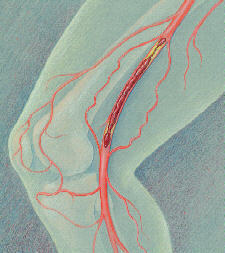Immobility and Travel May Cause Deep Vein Thrombosis
by
Joan Trombetti, Writer | July 17, 2007

DVT= bad news for travelers
(click to enlarge)
In a report released earlier this month, the World Health Organization (WHO) stated that the chances of deep vein thrombosis (DVT) developing double after flying four hours or more under cramped conditions. And according to WHO, this puts one in 6,000 travelers at risk for developing potentially deadly blood clots. At risk are taller individuals who have to cram their legs in economy class and very short people whose feet don't reach the floor of the plane. When these at-risk individuals remain seated without moving for four or more hours, the danger of clots increases.
WHO did research studying the Global Hazards of Travel (WRIGHT) that showed that those taking many flights in a short time span can also be at risk because the chances of developing venous thromboembolism (VTE) do not decrease altogether after the flight has ended, but rather remain elevated for four weeks or so.
These findings apply to planes, trains, buses and automobiles, according to Catherine Le Gales-Camus, assistant director general for non-communicable disease and mental health.
DVT is a blood clot, or thrombus that develops in a deep vein -- usually in the lower leg. The symptoms are mostly pain, tenderness and swelling, although symptoms may not present at all. DVT can be diagnosed by testing and can be treated; however, it is life threatening if thromboembolism is involved. When muscles can't contract, blood pools in the leg and causes a clot or thrombus that develops in deep veins. If the clot travels to the lung and blocks blood flow causing a pulmonary embolism that causes chest pain and breathing problems; it is potentially fatal if medical treatment is not immediately sought.
The best way to prevent blood clots according to Special Medical Advisor for WHO Shanthi Mendis is to exercise calf muscles up and down by moving feet and ankle joints. It is also recommended that travelers stop, or get up and move around every so often and avoid wearing tight clothing. Don't drink too much alcohol and don't take sleeping pills.
The second phase of this study by WHO (awaiting funding) will focus on identifying ways to prevent blood clots from occurring.
The WRIGHT study began in 2000, after media and public attention focused on the risk of thrombosis in long journeys. It was also initiated because of a report by the Select Committee on Science and Technology from the British House of Lords that recommended research about DVT -- after a meeting of experts brought together by WHO in March 2001, the WRIGHT project was started.
Other resources for travelers:
To read the CDC's "Yellow Book" on international travel risks, go to:
http://www.cdc.gov/od/oc/media/pressrel/2007/r070713.htm
In addition, revised International Health Regulations (2005) (IHR) go into effect in July 2007 for the United States. The updated rules are designed to prevent and protect against the international spread of diseases while minimizing interference with world travel and trade. They will help countries work together to identify, respond to, and share information about, public health emergencies of international concern. Read the details at: https://www.dotmed.com/news/story/4414
